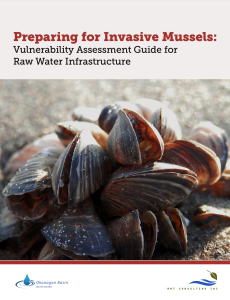Kelowna, B.C. – Syilx Territory – Organizations in the Pacific Northwest with water-related infrastructure can expect a new tool to be delivered this week to help keep their systems free of invasive mussels. The Okanagan Basin Water Board (OBWB), with the help of numerous partners, has developed a first-of-its-kind guide to proactively protect in-water infrastructure.
The guide, titled “Preparing for Invasive Mussels: Vulnerability Assessment Guide for Raw Water Infrastructure,” was a year-long collaborative effort between the OBWB and Renata Claudi from RNT Consulting, a leading researcher, author, and expert on invasive mussels in North America.
“The Water Board has been concerned about zebra and quagga mussels since 2012 when a study showed the Okanagan was at risk,” explains Blair Ireland, OBWB Chair and Mayor of Lake Country. “Since then, we have been a vocal advocate for prevention measures with our ‘Don’t Move A Mussel’ campaign, and ongoing support for B.C.’s Invasive Mussel Defence Program. Each year, we hear that mussel-infested watercraft have been intercepted on their way into B.C., so the importance of preparation cannot be clearer,” Ireland added.
The mussel vulnerability guide was developed to help organizations protect raw water infrastructure should an infestation take hold. Although the guide was developed in the Okanagan, every effort was made to ensure the information is relevant to utilities across the Pacific Northwest, helping the entire region become better prepared. And, although vulnerability assessments have been created previously for large hydroelectric dams and municipal water treatment plants, this is the first comprehensive guide developed for assessments across different types of water infrastructure – from small systems to industrial applications.
The guide was informed by decades of research and experience by Claudi and RNT Consulting and includes the most up-to-date research and techniques to proactively protect in-water infrastructure. It also includes a new mussel risk analysis table based on the latest water chemistry and habitat requirement research, a “how-to” for walking through a facility and determining risk to each system and component, and options for how to mitigate the risks and effects of invasive mussels. And, it provides a calculation to help operators estimate expected costs to their facility if mussels arrive.
According to James Littley, OBWB’s Deputy Administrator and the project’s lead, vulnerability assessments don’t remove the risk of invasive mussels, but they can help mitigate damage and reduce costs if mussels arrive. “If they had this guide in the Great Lakes in the 1980s, before the mussels arrived there, utilities probably could have saved hundreds of millions of dollars a year,” he added. In the early years of infestation in the Great Lakes, mussel management cost over $500 million per year to clean and maintain infrastructure. In addition, the mussels are known to wreak havoc on native ecosystems, attach to and damage the operating systems on watercraft, and litter beaches with razor-sharp shells.
Invasive mussels have not yet been detected in B.C., Alberta, Saskatchewan, Washington, Oregon or Montana, but this fall they were discovered in Idaho’s Snake River, and in Clear Lake, Manitoba, providing greater urgency to this project.

The OBWB acknowledges the support of technical reviewers from B.C. Ministry of Water, Land and Resource Stewardship, U.S. Bureau of Reclamation, Pacific States Marine Fisheries Commission, Idaho Power Company, Larratt Aquatic Consultants, City of Kelowna, District of Lake Country, and Greater Vernon Water, as well as several OBWB team members.
The guide can be found on the OBWB website at: https://tinyurl.com/Z-Q-Mussel-vulnerability-guide.
It has also been posted on the Don’t Move A Mussel website’s resources page.

